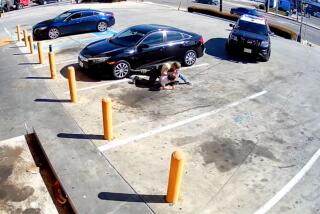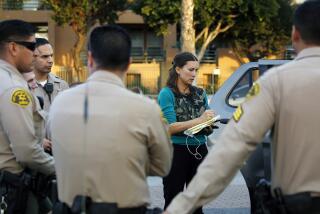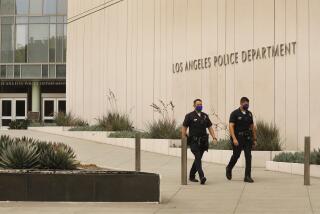CRISIS IN THE LAPD: THE RODNEY KING BEATING : Judge Says News Story Won’t Hurt Fair Trial : Courts: Jurist calls published confidential details ‘distractions’ in officers’ case. He orders a Times reporter to appear and disclose the source of the material.
- Share via
A judge overseeing the case of four police officers accused of beating motorist Rodney G. King said Wednesday that newly published details from a confidential Los Angeles Police Department report on the incident are “distractions,” but will not jeopardize a fair trial.
Los Angeles County Superior Court Judge Bernard J. Kamins also ordered a Times reporter who wrote the Tuesday article about the police report to appear in court next Thursday and reveal how he obtained the document.
Kamins had issued a subpoena Tuesday ordering a court appearance by staff writer Richard A. Serrano, but the reporter had not been served before the hearing Wednesday. A Times attorney told the judge that Serrano was on assignment.
Shelby Coffey III, editor of The Times, said, “Mr. Serrano and The Times will be represented at that hearing. Mr. Serrano has the complete backing and support of this newspaper.”
Coffey added that “both Mr. Serrano and The Times intend to assert all protections available to journalists under the U.S. and California constitutions against the forced disclosure of sources.”
Coffey insisted that Serrano and The Times had not “violated any court order,” nor had publication of the report “damaged the defendants’ right to a fair trial.”
“The Rodney King incident and its aftermath are of great importance to Los Angeles,” Coffey said. “The citizens of Southern California are best served by publication of important relevant information about the incident and The Times will continue to report on all aspects of the beating and its impact on city government.”
Under California’s shield law, journalists are protected from being forced to identify their sources of information for a story. The state Supreme Court has ruled that there are exceptions to the law.
Kamins, bemoaning a “tidal wave” of leaked material, warned that he might appoint an investigator to find out how The Times obtained the 314-page police Internal Affairs report if Serrano does not divulge his source. The document contains information compiled from 74 interviews, and includes synopses of police interviews with three of the four police defendants.
The Times reported Tuesday that the document indicated that all three of the officers had been advised of their rights not to be interviewed, and that each officer had waived those rights.
Despite the disclosures from the internal police report, made confidential under an April 30 protective order imposed by Kamins, the judge said he was “convinced, without a shadow of a doubt, that we can still get a fair jury. I’m not going to throw in the towel because of these distractions.”
The judge had ordered the document withheld from the public, contending that three police defendants had granted interviews to their department’s internal affairs investigators only under duress. The officers’ statements might not be considered admissible in court and could taint jurors if they were made public, Kamins had said Monday, upholding his earlier ruling.
At one point during the Wednesday morning hearing, the judge asked nearly a dozen prosecutors, defense attorneys and other lawyers and officials--all of whom had limited access to the report--if they were the source for the article.
Ordering each one placed under oath, Kamins then asked a single question: “Did you either directly or indirectly give out the Internal Affairs report involved in this case?”
One by one, the lawyers and officials swore that they had not.
Police Cmdr. Rick Dinse, who is heading the Internal Affairs probe of the March 3 King beating, was the first to deny his involvement. He was followed by a deputy city attorney, a counsel for the Christopher Commission investigating the Police Department, several deputy county prosecutors and a team of defense lawyers for the four police officers.
Despite his efforts to identify who leaked the material, Kamins said during the hearing that the statements contained in the news story on the police report were “minor” and not “really damaging to this case.”
“What can I do?” Kamins wondered. “The milk is already spilled here, the story’s out. How am I going to deal with this in the future? . . . I don’t think I can gag the newspapers.”
Kamins said “the integrity of the court” was his prime concern.
“What affects me more,” he said, “is (whether) someone is actually violating the court’s order.”
The judge suggested that if the Times reporter fails to identify his source, “he may be assisting a perjury . . . he could be covering up a crime.”
The Times story on the Internal Affairs report yielded new details of the beating, and was replete with contradictory accounts from alleged participants, police bystanders and witnesses. It offered the first full account of the incident by three of the four accused officers, who insisted that their actions were appropriate under the circumstances.
The story appeared the day after Kamins had turned down a request by a lawyer for the Christopher Commission to gain access to the 314-page report.
More to Read
Sign up for Essential California
The most important California stories and recommendations in your inbox every morning.
You may occasionally receive promotional content from the Los Angeles Times.










